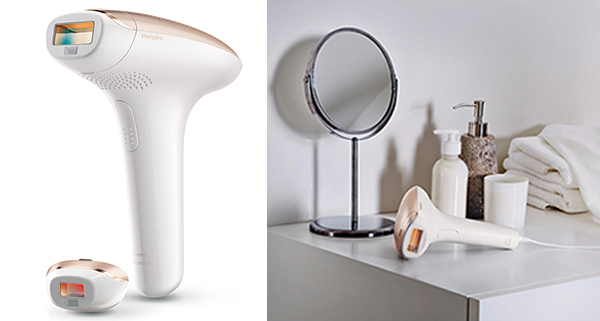Time-pressed, strategic spenders turn to at-home beauty care
By 손지영Published : Feb. 11, 2016 - 18:22
Despite her busy schedule, Kim Na-eun, a 30-year-old office worker in Seoul, visits a skin care clinic every now and then, whenever she feels the need to rejuvenate, or allot some “proper attention” to her skin.
These days, though, her visits have stopped -- not because she has stopped investing in skin care, but since she now relies on a set of high-end self-aesthetic devices instead to look after her skin.
Ranging from a rechargeable sonic skin cleansing brush to a microcurrent-generating facial massage roller, Kim is among the many avid users of advanced at-home beauty care devices that have been garnering high popularity both in South Korea and around the globe.
These days, though, her visits have stopped -- not because she has stopped investing in skin care, but since she now relies on a set of high-end self-aesthetic devices instead to look after her skin.
Ranging from a rechargeable sonic skin cleansing brush to a microcurrent-generating facial massage roller, Kim is among the many avid users of advanced at-home beauty care devices that have been garnering high popularity both in South Korea and around the globe.

“Though these home care devices are pretty pricy, they are a much cheaper option than regular visits to a skin clinic. Though the treatment effects may not be as dramatic or immediate (as professional care), the convenience and time saved are huge benefits,” Kim said.
Pressed for time and looking to spend more wisely in a slowing economy, Korea’s picky beauty consumers are turning to at-home aesthetic devices as convenient, effective and affordable ways to pamper their bodies.
Over the past few years, both foreign and local brands including Clarisonic, Philips, LG Household & Health Care and AmorePacific have introduced a diverse array of self-beauty devices -- sonic facial cleansers, high-tech massage rollers, makeup enhancers and at-home intense pulsed light laser hair removal systems and skin exfoliators, to name a few.
Despite their relatively high pricing -- from around 100,000 won ($83) to 500,000 won and up -- self-aesthetic devices have managed to strike the right chord with modern consumers, industry officals say.
“In a bad economy, local beauty spenders, mostly females in their late 20s to 40s, are carefully weighing the long-term costs and benefits of purchasing a given product or service,” said a Clarisonic representative, explaining why financially strained consumers choose to purchase pricy at-home beauty devices.
Home-fit devices, intended for long-term use, also cater well to a growing clientele who want to invest in skin care yet find it difficult to set aside enough time.
Some 75.1 percent of 2,000 Koreans surveyed responded that they “lacked time” last year, according to market research agency Macromill Embrain, which forecasts “home” as the key word that will shape and drive consumption patterns in 2016.

“Beauty spenders seeking simpler, time-efficient skin and body care treatment at home purchase self-aesthetic devices,” said an official from MakeOn, AmorePacific’s beauty device brand launched in 2014.
Such purchasing decisions are reflected by the rising sales of beauty devices in Korea and other developed countries.
G-market, a leading local e-commerce platform operated by eBay Korea, said sales of its at-home beauty devices increased 23 percent in 2015 compared to the previous year.
Auction, a similar platform operated by eBay, said sales of its skin care and massage devices rose 394 percent in 2015 over the year before.
“We expect this upward trend to continue,” said a representative from G-market, noting self-beauty care devices enable users to continuously benefit from high quality treatment at home through a one-time purchase, an appealing option when they have less to spend.
On a global level, the at-home beauty device market grew by nearly 14 percent in 2014, with the cleansing segment leading growth in Europe, China and South Korea, according to a 2015 report by Kline & Company.
As new companies jump in and existing brands diversify their product portfolios to appeal to a larger consumer base, the global at-home beauty device market is expected to continue growing by about 11 percent each year through 2017, according to Kline.
Market watchers foresee an array of new technologies to advance existing at-home beauty devices and give way to more highly functional devices in the years ahead, driving up user convenience, satisfaction and new demand.
“We expect the ‘Internet of Things’ technology and other skin- and body-related technologies to widen the scope of at-home beauty devices,” said an industry official.
By Sohn Ji-young (jys@heraldcorp.com)






![[From the Scene] Monks, Buddhists hail return of remains of Buddhas](http://res.heraldm.com/phpwas/restmb_idxmake.php?idx=644&simg=/content/image/2024/04/19/20240419050617_0.jpg&u=20240419175937)







![[From the Scene] Monks, Buddhists hail return of remains of Buddhas](http://res.heraldm.com/phpwas/restmb_idxmake.php?idx=652&simg=/content/image/2024/04/19/20240419050617_0.jpg&u=20240419175937)

![[KH Explains] Hyundai's full hybrid edge to pay off amid slow transition to pure EVs](http://res.heraldm.com/phpwas/restmb_idxmake.php?idx=652&simg=/content/image/2024/04/18/20240418050645_0.jpg&u=20240419100350)

![[Today’s K-pop] Illit drops debut single remix](http://res.heraldm.com/phpwas/restmb_idxmake.php?idx=642&simg=/content/image/2024/04/19/20240419050612_0.jpg&u=)